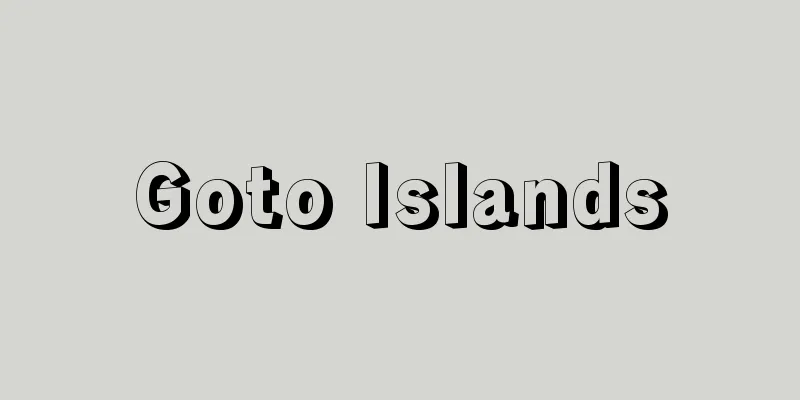Goto Islands

|
A group of islands in the East China Sea, west of Nagasaki Prefecture. It consists of five main islands, Nakadorijima, Wakamatsujima, Narujima, Hisakajima, and Fukuejima, arranged from northeast to southwest, and about 200 affiliated islands. It has a total length of about 80 kilometers and an area of 637.78 square kilometers. Administratively, it forms Goto City and Shinkamigoto Town in Minamimatsuura County. In ancient times, it was called Chika no Sato along with Hirado Island, and since it is the closest to the continent, it occupied an important position in foreign relations, serving as a port of call for envoys to the Tang Dynasty and a base for Japanese pirates, and there are many ruins of that time. In the Middle Ages, it was under the control of the Uku clan, and in the Edo period, most of the archipelago belonged to the Goto Domain (Fukue Domain), except for Ojika Island, which belonged to the Hirado Domain. After the Meiji period, the entire area was designated as a fortified zone, but this was dissolved after World War II, and in 1955 (Showa 30) various parts of the archipelago were designated as Saikai National Park. In a 1959 Prime Minister's Office notification, Uku Island, Ojika Island, Nozaki Island, etc., which belong to Kitamatsuura District, were added to the Hirado Islands, and the five main islands and their affiliated islands were called the Goto Islands. Population 62,696 (2010). [Yasuyoshi Ishii] NatureThe archipelago used to be a single landform mountain range stretching from northeast to southwest, but subsidence has divided it into five islands, with the Wakamatsu, Takigahara (Takigohara), Naru, and Tanoura Straits forming between the islands, as well as significant drowned valleys such as Tamanoura Bay. Sea cliffs have developed along the coast, with cliffs at Saganoshima reaching 130 meters and cliffs at Osezaki reaching 100 meters. On the east side of the landform mountain range are the Ondake volcano (315 meters) and Tadakariyama volcano, and on the west side are Kyonotake (183 meters), as well as Odake and Medake on Saganoshima. These, together with the ocean, create a unique natural landscape. [Yasuyoshi Ishii] industryIn the Edo period, farmers were divided into three occupations: local farmers, beach farmers, and kamakata farmers. The local farmers were primarily engaged in agriculture, the beach farmers were primarily engaged in fishing, and the kamakata farmers were primarily engaged in salt and charcoal production. In general, farmers north of Naru Island were primarily engaged in fishing and farming as a side job, while farmers south of Kugashima Island were primarily engaged in farming and fishing as a side job. The coast, washed by the warm Tsushima Current, is blessed with an abundance of fish species, and was once a major whaling center during the Goto Domain era. Today, the main industries are agri-ami (a type of purse seine) fishing for horse mackerel, mackerel, and sardines, as well as fixed net fishing for yellowtail and line fishing for squid, and the cultivation of yellowtail, shrimp, sea bream, and pearls is thriving. Goto dried squid is also a specialty product. Coral is also harvested in the waters off the Danjo Islands. The main agricultural industry is growing sweet potatoes on terraced fields, and there are many livestock farmers, making Goto beef a specialty. Tobacco leaf cultivation is thriving on Fukue Island. [Yasuyoshi Ishii] Characteristics of the villageThere are many Christian settlements that have existed since the Edo period, and cathedrals and churches can be seen throughout the area. There are many farming and fishing villages that continue intangible folk cultural assets such as nembutsu dances such as "Chankoko" and "Omonde", but productivity is generally low. The islands that belong to the archipelago, such as Himeshima, Orishima, and Kazurashima, have seen the disappearance of settlements (becoming uninhabited islands) due to a rapid outflow of population (the population of the entire archipelago has decreased by 37,867 in the 20 years since 1965). Major tourist spots include Onidake, Abunze lava coast, Osezaki Cliffs, Arakawa Onsen, Wakamatsu Marine Park, Akadake Cliffs, as well as Dozaki Church, the oldest church in Goto, and the ruins of Ishida Castle. [Yasuyoshi Ishii] [World Heritage Registration] The ruins of the settlements on Nozaki Island, Kashiragashima Island, Hisakashima Island, and Egami Village on Naru Island (Egami Cathedral and its surrounding area) were registered as World Heritage Sites by UNESCO (United Nations Educational, Scientific and Cultural Organization) in 2018 as component assets of the "Hidden Christian Sites in the Nagasaki Region" (World Cultural Heritage). [Editorial Department, September 19, 2018] trafficThere are regular flights from both Fukuoka and Nagasaki airports to Fukue airport. Jetfoils run from Nagasaki port to Narao port and Fukue port, ferry boats run to various parts of Goto, and high-speed boats and ferries run from Sasebo port to Arikawa port. There are also regular ferries that run from Hakata port to Fukue port via Hirado and various parts of Goto. [Yasuyoshi Ishii] "Goto Islands - Kujukushima - Hirado Island Academic Survey Report" (1952, Nagasaki Prefecture) "The Biological Life of Goto, edited by the Nagasaki Prefecture Biological Society" (1981, Nagasaki Publishing Culture Association) [References] | | | | | | | | | | | |Volcanic sea cliffs. Saikai National Park. Goto City, Nagasaki Prefecture © Nagasaki Tourism Federation Saganoshima Island Saikai National Park area. Fukue Island, Goto City, Nagasaki Prefecture ©Ministry of the Environment "> Osezaki (Goto City) View from Abumise on the southern foot of the mountain. Area of Saikai National Park. Fukue Island, Goto City, Nagasaki Prefecture ©Ministry of the Environment "> Onidake Goto City, Nagasaki Prefecture © Nagasaki Tourism Federation Chankoko Goto City, Nagasaki Prefecture © Nagasaki Tourism Federation Ormond Day Castle gate. Goto City, Nagasaki Prefecture © Nagasaki Prefectural Tourism Federation "> Fukue Castle (Ishida Castle) ruins Source: Shogakukan Encyclopedia Nipponica About Encyclopedia Nipponica Information | Legend |
|
長崎県西部、東シナ海に浮かぶ島嶼(とうしょ)群。北東から南西方向に並ぶ中通島(なかどおりじま)、若松島(わかまつじま)、奈留島(なるしま)、久賀島(ひさかじま)、福江島(ふくえじま)の五つの主島と約200の属島からなる。総延長約80キロメートル、面積637.78平方キロメートル。行政的には五島市と南松浦(みなみまつうら)郡新上五島町(しんかみごとうちょう)を形成。古くは、平戸島(ひらどしま)とともに値嘉郷(ちかのさと)とよばれ、大陸にもっとも近いので、遣唐使の寄港や倭寇(わこう)の根拠地となるなど、対外関係上重要な位置を占め、その遺跡も多い。中世は宇久(うく)氏の支配下にあり、江戸時代は小値賀島(おぢかじま)が平戸藩に属するほかは大部分が五島藩(福江藩)に属した。明治以後は全域にわたって要塞(ようさい)地帯に指定されたが、第二次世界大戦後解消され、1955年(昭和30)列島の各地が西海国立公園(さいかいこくりつこうえん)に指定されている。1959年の総理府告示では、北松浦郡に属する宇久島、小値賀島、野崎島などを平戸諸島に加え、前述の五つの主島とその属島を五島列島とよぶことにしている。人口6万2696(2010)。 [石井泰義] 自然列島は北東―南西方向の一つの地塁山地であったが、沈降によって五つの島に分かれ、各島間に若松、滝ヶ原(滝河原(たきごはら))、奈留、田ノ浦の瀬戸を生じ、また玉之浦湾(たまのうらわん)などの著しい溺れ谷(おぼれだに)を生じている。海岸には海食崖(がい)が発達、嵯峨ノ島(さがのしま)の断崖は130メートル、大瀬崎(おおせざき)では100メートルの断崖が延々と続いている。地塁山地の東側には鬼岳(おんだけ)火山(315メートル)、只狩山(ただかりやま)火山、西側には京ノ岳(きょうのたけ)(183メートル)、嵯峨ノ島の男岳(おだけ)、女岳(めだけ)などを噴出している。これらが海洋とともに特殊な自然景観を展開している。 [石井泰義] 産業江戸時代には、農民が地方(じかた)、浜方、竈方(かまかた)百姓の三つの職域に分化され、地方は農業、浜方は漁業、竈方は製塩、製炭を主とした歴史を背景に、だいたい、奈留島以北では主漁副農、久賀島以南では主農副漁となっている。対馬(つしま)暖流に洗われる沿岸は豊富な魚族に恵まれ、五島藩時代、一時は捕鯨の一大中心地でもあった。現在はアジ、サバ、イワシの揚繰網(あぐりあみ)(巻網の一種)を軸として、ブリの定置網やイカの一本釣りのほか、ハマチ、エビ、タイ、真珠などの養殖が盛んである。五島するめの特産もある。また、男女(だんじょ)群島近海ではサンゴ採取が行われる。農業は段々畑でのサツマイモ作が主で、有畜農家が多く五島牛の特産がある。福江島では葉タバコの栽培が盛ん。 [石井泰義] 集落の特色江戸時代以来のキリシタン集落が多く、各地に天主堂、教会がみられる。「チャンココ」や「オーモンデー」といった念仏踊などの無形民俗文化財を継承する農漁村が多いが、一般的には生産性は低い。姫島(ひめしま)、折島(おりしま)、葛島(かずらしま)などの属島では激しい人口流出に伴う集落の消滅(無人島化)がみられる(列島全体で、1965年から20年間に人口3万7867の減少)。おもな観光地には鬼岳、鐙瀬(あぶんぜ)溶岩海岸、大瀬崎断崖、荒川温泉、若松海域公園、赤岳断崖のほか、五島最古の歴史をもつ堂崎教会(どうざききょうかい)や石田城跡などがある。 [石井泰義] 〔世界遺産の登録〕野崎島の集落跡、頭ヶ島(かしらがしま)の集落、久賀島の集落、奈留島の江上集落(江上天主堂とその周辺)は、2018年(平成30)、ユネスコ(国連教育科学文化機関)により「長崎と天草(あまくさ)地方の潜伏キリシタン関連遺産」の構成資産として、世界遺産の文化遺産に登録された(世界文化遺産)。 [編集部 2018年9月19日] 交通福岡・長崎両空港から福江空港への定期空路がある。長崎港から奈良尾(ならお)港、福江港へはジェットフォイルが就航し、五島各地へはフェリーボートが、佐世保(させぼ)港から有川(ありかわ)港には高速船とフェリーが運航される。ほかに博多(はかた)港から平戸経由で五島各地を経て福江港に至る定期船がある。 [石井泰義] 『『五島列島―九十九島―平戸島学術調査書』(1952・長崎県)』▽『長崎県生物学会編『五島の生物』(1981・長崎出版文化協会)』 [参照項目] | | | | | | | | | | | |火山海食崖。西海国立公園域。長崎県五島市©一般社団法人長崎県観光連盟"> 嵯峨ノ島 西海国立公園域。長崎県五島市 福江島©環境省"> 大瀬崎〈五島市〉 南麓の鐙瀬付近からの眺望。西海国立公園域。長崎県五島市 福江島©環境省"> 鬼岳 長崎県五島市©一般社団法人長崎県観光連盟"> チャンココ 長崎県五島市©一般社団法人長崎県観光連盟"> オーモンデー 城門。長崎県五島市©一般社団法人長崎県観光連盟"> 福江城(石田城)跡 出典 小学館 日本大百科全書(ニッポニカ)日本大百科全書(ニッポニカ)について 情報 | 凡例 |
Recommend
Birth bath - Ubuyu
This is the bath water given to newborn babies. V...
planter
...Plastic pots can be freely colored and have th...
Kii Channel
The sea area between northwestern Wakayama Prefec...
Cavalli, PF (English spelling) CavalliPF
… [17th-18th century] Renaissance comedy, written...
Aizu Rokugun Rengokai
...In February 1882, the governor of the prefectu...
Coendous
...A arboreal porcupine with a long tail that can...
Communal land ownership
…Land ownership is one way in which humans are co...
Picture frame stage (English: picture frame stage)
A stage that is framed by a proscenium arch and ex...
American architecture - United States architecture
American architecture from the 17th century to the...
montane rain forest
…the leaves are smaller than those in the tropics...
Freight charges - Kamotsuunchin
...There is no theoretical basis for the legal di...
Okuyuhitsu
A title of a job in the Edo Shogunate. A position ...
Tourist inn - Kankoryokan
…With the development of railways after the Meiji...
《Israelites in Egypt》
… Handel made a miraculous comeback at the end of...
Inatsuki [town] - Inatsuki
Kama is an old town in Kaho District, in the middl...




![Legitimacy (orthodoxy) - Legitimität [Germany]](/upload/images/67cbfffc4a318.webp)




